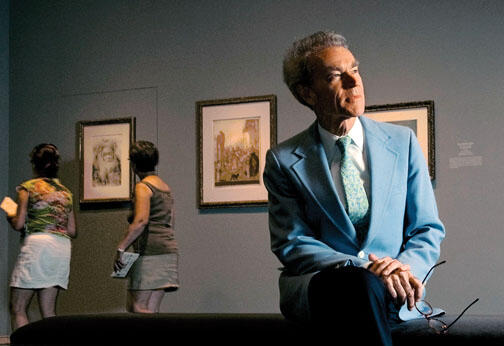A fire breaks out at a museum, or there is a bomb scare. It’s a curator’s worst nightmare. Disaster-preparedness demands that tough decisions be made about which art objects should be saved and which left behind, possibly to face destruction.
At the National Gallery of Art in Washington, D.C., Andrew Robison ’62 *74 is thinking about just this kind of thing. In fact, more than 30 years ago, Robison, the curator of prints and drawings, began gathering certain works on paper that he deemed of critical importance not only to the nation but to the world. In a catastrophe, these would be rescued even if nothing else from his department was. With a streak of ghoulish humor, he stashed them in black-colored boxes labeled “WW3.”
Today, there are seven WW3 boxes housing about 80 artworks, a small fraction of the museum’s collection of 100,000 works on paper, which has doubled under Robison’s watch. These are the precious few items that are to be gathered up in staffers’ arms and sprinted to safety. “It’s like the sinking of the Titanic,” he explains. “Some people get into the lifeboats, and some don’t.”
In making decisions regarding his boxes, Robison quickly realized that “monetary value is not a good criterion. A mediocre Leonardo or Rembrandt is automatically worth much more on the art market than a brilliant Canaletto or a splendid Munch.” The goal is not to rescue mediocrities, but rather works of unsurpassed significance.
Instead, Robison chooses masters “of a high level of importance,” then asks, “Which of their works, if lost, would seriously impede our understanding of this artist?” By its nature, such decision-making is comparative. “Suppose you have to decide between a Degas pastel, a Gauguin watercolor, and a van Dyke drawing. You have to ask for each of them, are there others this good in the world?”
Constant traveling has brought him into contact with great foreign collections, often causing him to re-evaluate the contents of the boxes. “That Sargent watercolor isn’t so great as we thought; there are others,” he gives by way of example. “Or that Rembrandt — is it even by Rembrandt?” As a result of such rethinking, only 27 percent of the artworks placed in the boxes in 1979 remain, the rest having been swapped out.
Robison relishes all this decision-making. “It becomes philosophical” — touching upon the meanings of culture itself and what people value, he says. His longstanding love of philosophy “goes back to Princeton,” he says, where he earned a doctorate in the field before becoming a philosophy professor at the University of Illinois — a position he held until the National Gallery lured him away in 1974.
A hobby begun in college days led to his current job; he never has taken an art history course. As an undergraduate, he majored in religion. But he fell in with a group of faculty members, including art history professor Robert Koch *54, who collected prints and were eager to encourage others. “They certainly put me on the right track,” Robison says. In his spare time, he leafed through Princeton’s collection of Piranesi engravings and began noticing details no one else had. Soon he was hooked.
On one level, the WW3 boxes are a thought-game, intriguing in their philosophical implications. But Robison takes them seriously. “Beyond what’s important for me or this museum or even this country, we’re making a worldwide decision,” he says. In the case of some epic disaster, his choices might make a profound difference. “But of course,” he adds, “you never want to choose among your children.”












No responses yet